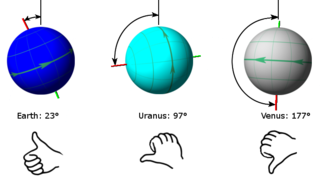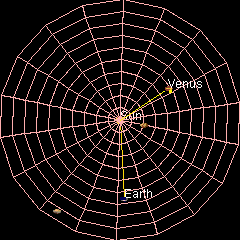Related Research Articles

The astronomical unit is a unit of length defined to be exactly equal to 149,597,870,700 m. Historically, the astronomical unit was conceived as the average Earth-Sun distance, before its modern redefinition in 2012.

The ecliptic or ecliptic plane is the orbital plane of Earth around the Sun. From the perspective of an observer on Earth, the Sun's movement around the celestial sphere over the course of a year traces out a path along the ecliptic against the background of stars. The ecliptic is an important reference plane and is the basis of the ecliptic coordinate system.
The term ephemeris time can in principle refer to time in association with any ephemeris. In practice it has been used more specifically to refer to:
- a former standard astronomical time scale adopted in 1952 by the IAU, and superseded during the 1970s. This time scale was proposed in 1948, to overcome the disadvantages of irregularly fluctuating mean solar time. The intent was to define a uniform time based on Newtonian theory. Ephemeris time was a first application of the concept of a dynamical time scale, in which the time and time scale are defined implicitly, inferred from the observed position of an astronomical object via the dynamical theory of its motion.
- a modern relativistic coordinate time scale, implemented by the JPL ephemeris time argument Teph, in a series of numerically integrated Development Ephemerides. Among them is the DE405 ephemeris in widespread current use. The time scale represented by Teph is closely related to, but distinct from, the TCB time scale currently adopted as a standard by the IAU.
A time standard is a specification for measuring time: either the rate at which time passes or points in time or both. In modern times, several time specifications have been officially recognized as standards, where formerly they were matters of custom and practice. An example of a kind of time standard can be a time scale, specifying a method for measuring divisions of time. A standard for civil time can specify both time intervals and time-of-day.

In astronomy, axial tilt, also known as obliquity, is the angle between an object's rotational axis and its orbital axis, which is the line perpendicular to its orbital plane; equivalently, it is the angle between its equatorial plane and orbital plane. It differs from orbital inclination.
In astronomy and celestial navigation, an ephemeris is a book with tables that gives the trajectory of naturally occurring astronomical objects and artificial satellites in the sky, i.e., the position over time. Historically, positions were given as printed tables of values, given at regular intervals of date and time. The calculation of these tables was one of the first applications of mechanical computers. Modern ephemerides are often provided in electronic form. However, printed ephemerides are still produced, as they are useful when computational devices are not available.

Radar astronomy is a technique of observing nearby astronomical objects by reflecting radio waves or microwaves off target objects and analyzing their reflections. Radar astronomy differs from radio astronomy in that the latter is a passive observation and the former an active one. Radar systems have been conducted for six decades applied to a wide range of Solar System studies. The radar transmission may either be pulsed or continuous. The strength of the radar return signal is proportional to the inverse fourth-power of the distance. Upgraded facilities, increased transceiver power, and improved apparatus have increased observational opportunities.
Barycentric Dynamical Time is a relativistic coordinate time scale, intended for astronomical use as a time standard to take account of time dilation when calculating orbits and astronomical ephemerides of planets, asteroids, comets and interplanetary spacecraft in the Solar System. TDB is now defined as a linear scaling of Barycentric Coordinate Time (TCB). A feature that distinguishes TDB from TCB is that TDB, when observed from the Earth's surface, has a difference from Terrestrial Time (TT) that is about as small as can be practically arranged with consistent definition: the differences are mainly periodic, and overall will remain at less than 2 milliseconds for several millennia.
Newcomb's Tables of the Sun is a work by the American astronomer and mathematician Simon Newcomb, published in volume VI of the serial publication Astronomical Papers Prepared for the Use of the American Ephemeris and Nautical Almanac. The work contains Newcomb's mathematical development of the position of the Earth in the Solar System, which is constructed from classical celestial mechanics as well as centuries of astronomical measurements. The bulk of the work, however, is a collection of tabulated precomputed values that provide the position of the sun at any point in time.
An astronomical constant is any of several physical constants used in astronomy. Formal sets of constants, along with recommended values, have been defined by the International Astronomical Union (IAU) several times: in 1964 and in 1976. In 2009 the IAU adopted a new current set, and recognizing that new observations and techniques continuously provide better values for these constants, they decided to not fix these values, but have the Working Group on Numerical Standards continuously maintain a set of Current Best Estimates. The set of constants is widely reproduced in publications such as the Astronomical Almanac of the United States Naval Observatory and HM Nautical Almanac Office.
Lunar theory attempts to account for the motions of the Moon. There are many small variations in the Moon's motion, and many attempts have been made to account for them. After centuries of being problematic, lunar motion can now be modeled to a very high degree of accuracy.
The Astronomical Almanac is an almanac published by the United Kingdom Hydrographic Office; it also includes data supplied by many scientists from around the world. On page vii, the listed major contributors to its various Sections are: H.M Nautical Almanac Office, United Kingdom Hydrographic Office; the Nautical Almanac Office, United States Naval Observatory; the Jet Propulsion Laboratory, California Institute of Technology; the IAU Standards Of Fundamental Astronomy (SOFA) initiative; the Institut de Mécanique Céleste et des Calcul des Éphémerides, Paris Observatory; and the Minor Planet Center, Cambridge, Massachusetts.
Elena Vladimirovna Pitjeva is a Russian astronomer working at the Institute of Applied Astronomy, Russian Academy of Sciences, St. Petersburg. She has published over 100 articles, as listed in Google Scholar and the Astrophysics Data System in the field of solar system dynamics and celestial mechanics.
Jet Propulsion Laboratory Development Ephemeris designates one of a series of mathematical models of the Solar System produced at the Jet Propulsion Laboratory in Pasadena, California, for use in spacecraft navigation and astronomy. The models consist of numeric representations of positions, velocities and accelerations of major Solar System bodies, tabulated at equally spaced intervals of time, covering a specified span of years. Barycentric rectangular coordinates of the Sun, eight major planets and Pluto, and geocentric coordinates of the Moon are tabulated.
In astronomy, planetary mass is a measure of the mass of a planet-like astronomical object. Within the Solar System, planets are usually measured in the astronomical system of units, where the unit of mass is the solar mass (M☉), the mass of the Sun. In the study of extrasolar planets, the unit of measure is typically the mass of Jupiter (MJ) for large gas giant planets, and the mass of Earth (ME) for smaller rocky terrestrial planets.
Éphéméride Lunaire Parisienne is a lunar theory developed by Jean Chapront, Michelle Chapront-Touzé, and others at the Bureau des Longitudes in the 1970s to 1990s.
A fundamental ephemeris of the Solar System is a model of the objects of the system in space, with all of their positions and motions accurately represented. It is intended to be a high-precision primary reference for prediction and observation of those positions and motions, and which provides a basis for further refinement of the model. It is generally not intended to cover the entire life of the Solar System; usually a short-duration time span, perhaps a few centuries, is represented to high accuracy. Some long ephemerides cover several millennia to medium accuracy.
The JPL Small-Body Database (SBDB) is an astronomy database about small Solar System bodies. It is maintained by Jet Propulsion Laboratory (JPL) and NASA and provides data for all known asteroids and several comets, including orbital parameters and diagrams, physical diagrams, close approach details, radar astrometry, discovery circumstances, alternate designations and lists of publications related to the small body. The database is updated daily when new observations are available. In April 2021 the JPL Small-Body Database started using planetary ephemeris (DE441) and small-body perturber SB441-N16. Most objects such as asteroids get a two-body solution (Sun+object) recomputed twice a year. Comets generally have their two-body orbits computed at a time near the perihelion passage as to have the two-body orbit more reasonably accurate for both before and after perihelion. For most asteroids, the epoch used to define an orbit is updated twice a year. Orbital uncertainties in the JPL Small-Body Database are listed at the 1-sigma level.

Venus has an orbit with a semi-major axis of 0.723 au, and an eccentricity of 0.007. The low eccentricity and comparatively small size of its orbit give Venus the least range in distance between perihelion and aphelion of the planets: 1.46 million km. The planet orbits the Sun once every 225 days and travels 4.54 au in doing so, giving an average orbital speed of 35 km/s (78,000 mph).

(620094) 2016 AJ193 (provisional designation 2016 AJ193; also known as 2010 KV134) is a near-Earth object and potentially hazardous asteroid of the Apollo group, approximately 1.4 kilometres (0.87 mi) in diameter. It was discovered on 17 May 2010 by the Wide-field Infrared Survey Explorer (WISE) satellite, but was lost until it was reobserved on 16 January 2016. With an observation arc over 11 years, 2016 AJ193 has a well-determined orbit and trajectory through the year 2086. The asteroid's orbit is only potentially hazardous on a time scale of thousands of years.
References
- ↑ Standish, E. M., Jr.; Keesey, M. S. W.; and Newhall, X. X. (Feb 1976), JPL Development Ephemeris number 96
- ↑ Newhall, X. X., Standish, E. M., & Williams, J. G (1983), DE 102 – A numerically integrated ephemeris of the moon and planets spanning forty-four centuries Astronomy and Astrophysics (ISSN 0004-6361), vol. 125, no. 1, Aug. 1983, pp. 150–167. (The long ephemeris DE102 has since been superseded by DE406, which is a long (6000-year) version of the current standard DE405.)
- ↑ For example E M Standish (1997) Jet Propulsion Laboratory Planetary and Lunar Ephemerides, (including DE200, DE405 and DE406) published on CD-ROM and other (e.g. online) formats.
- ↑ "(History of USNO Almanac Publications)". Archived from the original on 2009-03-05. Retrieved 2009-02-27.
- ↑ Standish, E. M. & Nobili, A. M. (1997), Galileo's observations of Neptune, Baltic Astronomy, vol. 6, pp. 97–104.